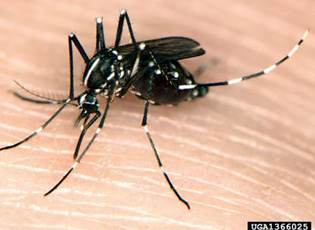by Kelly Middleton
San Gabriel Valley Mosquito & Vector Control District
After identifying Asian tiger mosquitoes (Aedes albopictus) in the cities of El Monte and South El Monte this month, the Greater Los Angeles County Vector Control District and the San Gabriel Valley Mosquito & Vector Control District are collaborating in a campaign to conduct neighborhood surveillance, control, and outreach to raise awareness and determine the extent of the Asian tiger mosquito infestation in Los Angeles County. Previous door-to-door campaigns conducted separately by these public health agencies yielded numerous sites where mosquitoes were breeding and adult mosquitoes were present throughout the surveyed area.
Image: US Department of Agriculture
 “If the Asian tiger mosquito becomes established here in LA County, it would be a game changer for all of us. Residents would need to be concerned about disease-transmitting mosquitoes biting them during the day,” said Truc Dever, GLACVCD Director of Community Affairs. “We need the public’s help in order to control and eradicate this dangerous pest. We are asking everyone to call us if they are getting bitten by mosquitoes during the day.”
“If the Asian tiger mosquito becomes established here in LA County, it would be a game changer for all of us. Residents would need to be concerned about disease-transmitting mosquitoes biting them during the day,” said Truc Dever, GLACVCD Director of Community Affairs. “We need the public’s help in order to control and eradicate this dangerous pest. We are asking everyone to call us if they are getting bitten by mosquitoes during the day.”
Asian tiger mosquitoes (Aedes albopictus) are native to Southeast Asia and were first found in the United States in 1985. Since then, the species has spread throughout the southeast and eastern U.S.
Unlike most mosquitoes native to California, the Asian tiger mosquitoes are aggressive day-time biters and efficiently carry and transmit dengue, yellow fever, chikungunya, and West Nile viruses, dog heartworm, and several other viruses that can cause encephalitis. Asian tiger mosquitoes are responsible for recent outbreaks of dengue virus in south Florida, Texas, and Hawai’i. They are approximately ¼ inch long and have distinctive black and white bands across their body and legs. These mosquitoes are considered “container breeders” and require very little water to lay eggs and breed. Females will lay individual eggs next to the water surface in buckets, flower pots, and even trash. They will also lay eggs in natural containers such as tree holes, bamboo, and inside flowering plants such as bromeliads. The eggs can remain viable for years in the right environment and hatch once the eggs are re-flooded with water.
 Christ the Shepherd Lutheran Church invites the community to a giant fish fry and bake sale on Sat., Oct. 15, 11 AM-3 PM, 185 West Altadena Drive (corner of Glenrose).
Christ the Shepherd Lutheran Church invites the community to a giant fish fry and bake sale on Sat., Oct. 15, 11 AM-3 PM, 185 West Altadena Drive (corner of Glenrose).